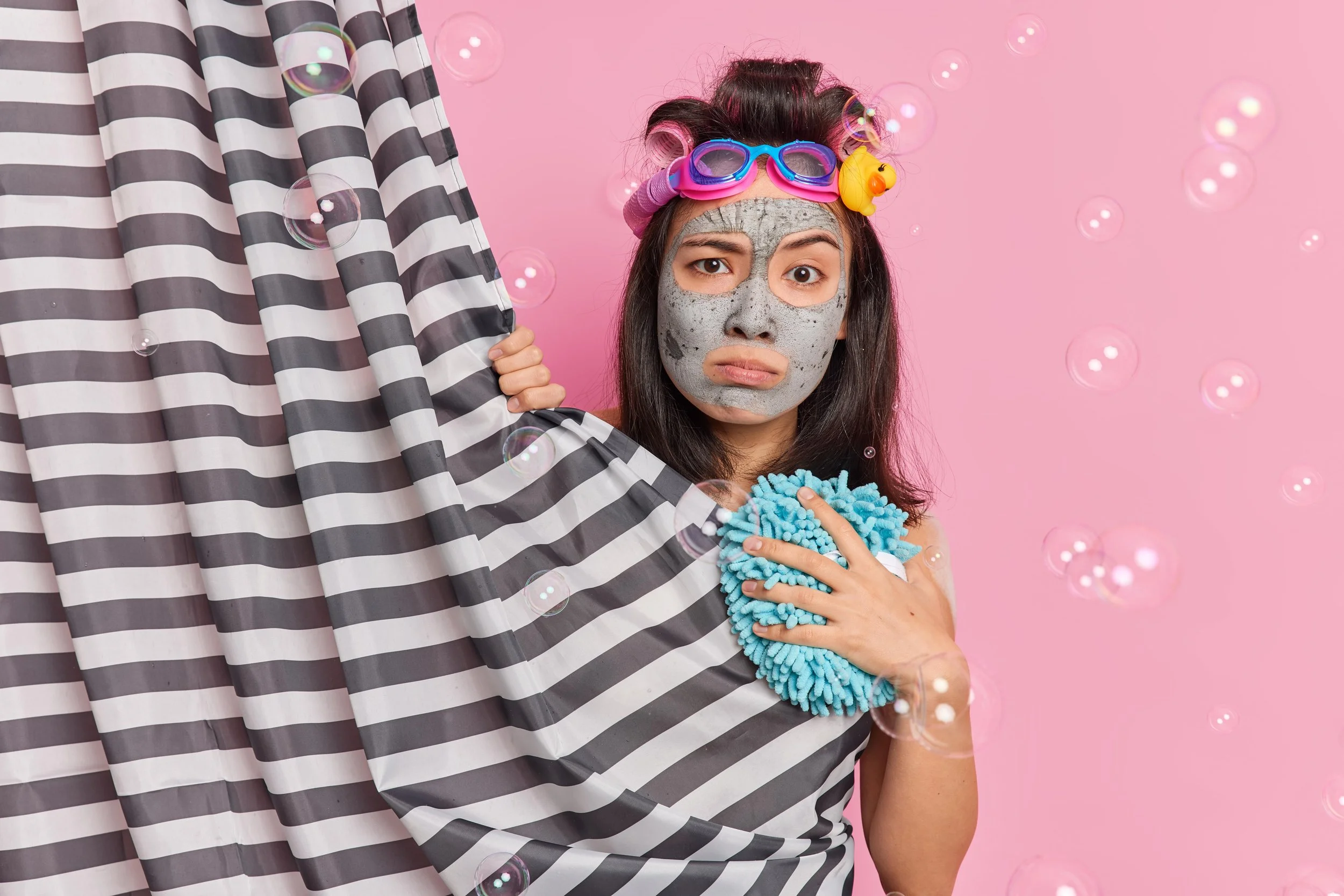How to Treat Chest and Back Acne (Not Just Your Face)
This post contains affiliate links. As an Amazon Associate, I earn from qualifying purchases—at no extra cost to you. I only recommend products I truly believe in.
Your Face Isn’t the Only Diva—Let’s Talk Body Breakouts
Let’s be real—just when you think you’ve got your face under control, boom: your chest and back decide to go through their own rebellious phase. Surprise! Acne isn’t just a face thing. And no, you’re not weird for Googling “why do I have pimples on my shoulder blades?” at 11 p.m.
Here’s the truth: body breakouts are super common. Research shows that about 61% of people with acne also deal with it on their chest, and around 45% get it on their back too¹. But unlike facial acne—which gets all the attention, all the serums, all the Sephora shelf space—truncal acne (yes, that’s the fancy term) is often ignored. Until summer hits. Or strapless season. Or, let’s be honest, until you accidentally scratch one and it reminds you it’s there.
This post is your no-nonsense, cheeky-sciencey guide to treating chest and back acne like the skincare priority it deserves to be. We’ll break down the causes, the best treatments (from fancy sprays to derm-approved body washes), and why you really need to stop scrubbing like you’re trying to sand your back into glass.
Why Is My Chest Acting Like a Teenager?
First of all, no—you’re not cursed. Body acne is not a personal failure. It’s biology. Your chest and back have more sebaceous glands (aka oil factories) than most areas of your body, and they’re just as susceptible to clogging, inflammation, and overreacting to life as your face is.
Here’s what’s usually fueling the breakout bonfire:
Excess oil + dead skin cells = perfect pore-clogging storm
Friction from clothing or gear (looking at you, sports bras, backpacks, and anything that traps sweat)
Sweat that sits too long—especially post-gym or on hot days
Hormonal fluctuations—yep, same deal as face acne
Acne mechanica: the fancy term for breakouts caused by heat, pressure, and rubbing on the skin
And because we tend to neglect our body skincare routine (be honest—when’s the last time you moisturized your back on purpose?), these breakouts can get irritated fast.
The result? Angry red bumps, clogged pores that overstayed their welcome, and flare-ups that make you want to cancel tank tops forever.
Backne Be Gone: The Science-Backed Solutions
So you’ve got chest or back acne. What now? The good news: there are actual, research-backed ways to treat it—and no, they don’t involve scrubbing your skin off or praying to the skincare gods with a bar of Irish Spring.
Let’s break it down:
🧼 Topical Treatments That Actually Work
Salicylic Acid (2%)
This beta hydroxy acid dives deep into your pores, dissolves excess oil, and gently exfoliates dead skin cells before they turn into breakouts.
💡 Look for it in body washes or sprays you can reach your back with—bonus points if it’s fragrance-free.Benzoyl Peroxide (2.5–5%)
The bacteria-fighting MVP. It helps kill C. acnes (the breakout-causing kind), and it doesn’t lead to resistance like antibiotics can.
💡 Start low (2.5%) to avoid bleaching your towels and your spine.Retinoids (like adapalene)
These power players increase cell turnover, unclog pores, and reduce inflammation. They're ideal for stubborn breakouts and acne that keeps coming back.
💡 Best used at night—and pair it with a gentle, non-stripping cleanser.
💊 Systemic Options (aka When Topicals Aren’t Enough)
Oral antibiotics: If your body acne is widespread, painful, or cystic, dermatologists may prescribe oral antibiotics to calm things down fast.
Hormonal therapies: For acne tied to hormonal swings (especially in women), spironolactone or birth control pills can help reduce oil production systemically.
👉 These require a derm visit—but are game-changers if OTC isn’t cutting it.
🧺 Lifestyle Fixes That Make a Big Difference
Shower ASAP after sweating (gym, sun, life in general)
Use a clean towel every time—especially after body wash
Wear breathable fabrics—synthetics trap sweat and friction = acne mechanica
Avoid over-scrubbing—it doesn’t “clean” your acne; it just makes it mad
Back and chest acne aren’t about being dirty—they’re about being human, with oil glands in awkward places.
Premium Picks: Because Your Back Deserves the Best
Just because it's behind you doesn't mean it should get the bargain bin treatment. Your chest and back deserve the same level of care as your face—especially when they're throwing tantrums in the form of inflamed breakouts.
If you’re ready to treat your chest and back like actual skincare zones, these products are a solid place to start.
Paula’s Choice Weightless Body Treatment 2% BHA
A cult-favorite lotion with salicylic acid that smooths bumps, treats breakouts, and hydrates all at once. Ideal for daily use on the chest and shoulders.
CeraVe SA Body Wash for Rough & Bumpy Skin
Derm-developed with salicylic acid, ceramides, and niacinamide—it gently exfoliates without over-drying and is safe for daily use.
Murad Acne Body Wash
Formulated with glycolic acid, salicylic acid, and green tea extract to cleanse and soothe active breakouts without stripping the skin barrier.
PanOxyl Acne Foaming Wash (10% Benzoyl Peroxide)
A maximum-strength benzoyl peroxide wash that effectively treats body acne.
CeraVe Acne Foaming Cream Cleanser (4% Benzoyl Peroxide)
A gentler benzoyl peroxide option that includes ceramides for barrier support.
Differin Acne Treatment Gel (0.1% Adapalene)
An over-the-counter retinoid that works for facial and body acne by speeding up skin cell turnover and preventing clogged pores.
La Roche-Posay Effaclar Adapalene Gel 0.1%
Same active as Differin, but formulated for sensitive skin with that premium French pharmacy flair.
Myth-Busting: No, Toothpaste Isn’t the Answer
Let’s be honest—when it comes to chest and back acne, the internet has thoughts. So let’s take a moment to lovingly snatch the mic from every well-meaning Reddit thread, TikTok tip, and grandma suggestion that’s doing more harm than good.
Here’s what you don’t need to do:
❌ Myth #1: “Sun exposure clears body acne”
Tempting, right? A little sun, a little tan, and suddenly things look better. But what’s actually happening is temporary drying—followed by rebound oil production and inflammation. Not to mention the whole “increased skin cancer risk” part.
☀️ Science says: Skip the bake. Stick with non-comedogenic mineral sunscreen.
❌ Myth #2: “Toothpaste dries up breakouts”
Technically? Sure, if you count irritation, burning, and a side of peeling as “drying.” Toothpaste isn’t formulated for skin—it’s designed to polish enamel. Let’s leave it in the bathroom drawer where it belongs.
🧴 Science says: Salicylic acid or benzoyl peroxide > minty goo.
❌ Myth #3: “Just scrub it harder”
If you're treating your back like it’s grout that needs regrouting... please stop. Over-exfoliating can damage your skin barrier, trap bacteria deeper, and cause more inflammation.
🧼 Science says: Use gentle exfoliants 2–3 times a week max, and let ingredients do the heavy lifting.
💪When to Call in the Pros
Sometimes no matter how many sprays, scrubs, or science-backed routines you throw at it, your chest or back just won’t chill out. And that’s okay.
Here’s when it might be time to get a derm involved:
Your breakouts are painful, deep, or leave dark marks behind
You’ve tried OTC products for 6–8 weeks with zero results
You suspect hormones, meds, or underlying health stuff might be involved
You’re getting cystic acne—those under-the-skin, slow-healing beasts that feel like mini volcanoes
A dermatologist can offer stronger topicals, oral meds, or even in-office treatments like chemical peels or laser therapy—especially for treating lingering dark spots or scarring.
No shame. No “I should’ve fixed it myself.”
Sometimes the best flex is calling in backup and getting it done right.
Your Skin, Your Rules
Whether it’s your cheeks, your shoulders, or that impossible-to-reach patch right between your shoulder blades—acne doesn’t get to boss you around.
With the right products, a little science, and a lot of consistency, you can clear your chest and back breakouts—without burning your skin off or scrubbing like you’re refinishing furniture.
Start with ingredients that work.
Stick with it longer than a week.
And know when it’s time to tag in a derm.
Because good skincare isn’t about being perfect.
It’s about finding what works for your body—and owning it.
Want to dig deepeR?
Before treating body acne, make sure you know exactly what you’re working with. Here’s how to tell whether your breakouts are cystic, hormonal, or fungal.
Since sweat and friction make body acne worse, start with a cleanser that cuts oil without drying out your skin. These summer-friendly cleansers do exactly that.
Once your skin’s clean and calm, keep it balanced with a lightweight moisturizer that won’t clog pores. These formulas hydrate without heaviness.
📚References
Alexis, A. F., Blackcloud, P. (2019). Truncal acne: A neglected entity. Journal of Drugs in Dermatology, 18(12), 1205–1208.
Dreno, B., Thiboutot, D., Gollnick, H., et al. (2018). Antibiotic stewardship in dermatology: limiting antibiotic use in acne. European Journal of Dermatology, 28(3), 322–327.
Zaenglein, A. L., Pathy, A. L., Schlosser, B. J., et al. (2016). Guidelines of care for the management of acne vulgaris. Journal of the American Academy of Dermatology, 74(5), 945–973.e33.
Kraft, J., Freiman, A. (2011). Management of acne. Canadian Medical Association Journal, 183(7), E430–E435.
Dall’Oglio, F., Tedeschi, A., Micali, G. (2021). Acne mechanica in athletes: A review of clinical features, contributing factors and treatment. Dermatology Reports, 13(3), 9333.
Rigopoulos, D., Katsambas, A. (2010). The role of the skin barrier in acne pathogenesis and treatment. Clinics in Dermatology, 28(1), 17–20.
Baldwin, H. E. (2002). The interaction between acne vulgaris and the skin barrier. Dermatology, 204(2), 102–108.


